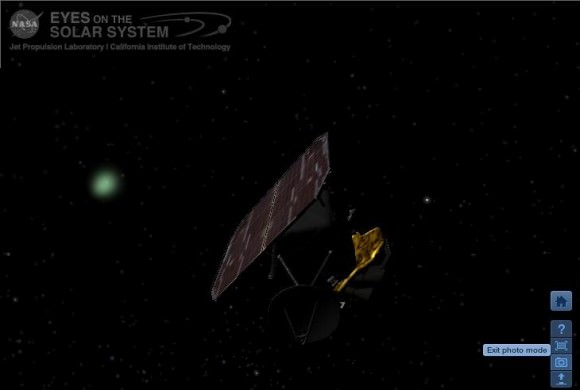[/caption]
NASA’s beta version of Eyes on the Solar System, built by JPL and Caltech, offers a neat way of tracking a range of current space missions – for example, as Nancy Atkinson mentioned yesterday, you can follow EPOXI’s flyby of comet Hartley 2. Reminiscent of Celestia, this browser application gives you a 3D environment running in real time and is updated regularly with NASA spacecraft mission data.
To get it operating, you can just click to the NASA link where you are prompted to install a Unity Web Player plug-in. This is fast and straight forward, from my experience. I did strike a problem with a certain small and squishy 64bit system that starts with X (where the menu text didn’t display correctly), but it ran fine on other systems. It is a beta version after all – and I feel obliged to note you should load at your own risk, yada, yada.
Anyhow, if you choose to proceed, you can then move around the solar system with left mouse click-hold and scroll wheel actions – or there’s the usual keyboard alternatives, or even on-screen controls. In default mode, a number of celestial bodies are shown and labeled, as are several spacecraft, which you can zoom over to by clicking on them. You can add more objects from the Visual Controls menu. Default settings have comets hidden, so you’ll need to add them to do an EPOXI-Hartley 2 encounter simulation.
There are some online tutorials you can take from the opening screen – which are short and useful – to get a quick run-through of the options available.

Like Celestia, you can speed up, slow down and move back and forth through time. This means you can replay EPOXI’s closest approach to Hartley 2 – or go right back to 1997 and zoom out to watch Cassini leave Earth and travel to Saturn via Venus and Earth flybys until it reaches Saturn in 2004 – all of which you can enjoy in about 5 seconds after cranking up the passage of time. You can also pick an ‘over the shoulder’ view to ride with Cassini through the F and G rings on its first approach to Saturn.
Unlike Celestia, because Eyes is mainly about spacecraft missions, its environment only covers the period from 1950 to 2050 and (curses) I couldn’t find any options to add in fictional spacecraft.
For a bit of edu-tainment you can access right-click controls which allow you to measure distances between objects – and monitor how those distances change as the objects move over time. For a bit of fun, you can also compare spacecraft to scale objects – with a choice between scientist, Porsche and football stadium. As one of the brief tutorials will explain, Voyager 1 is about the size of a Porsche.

